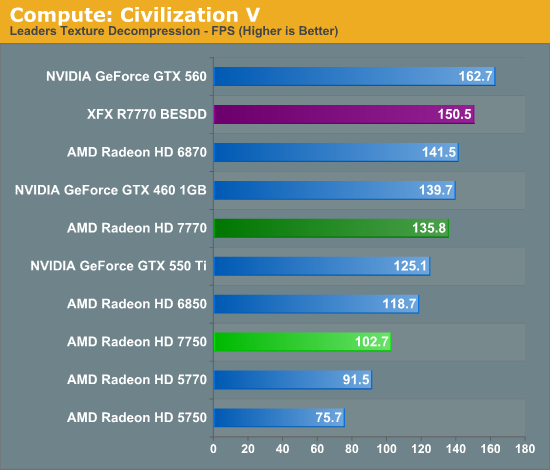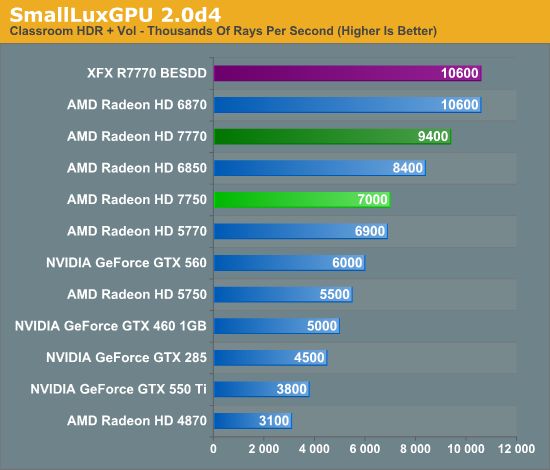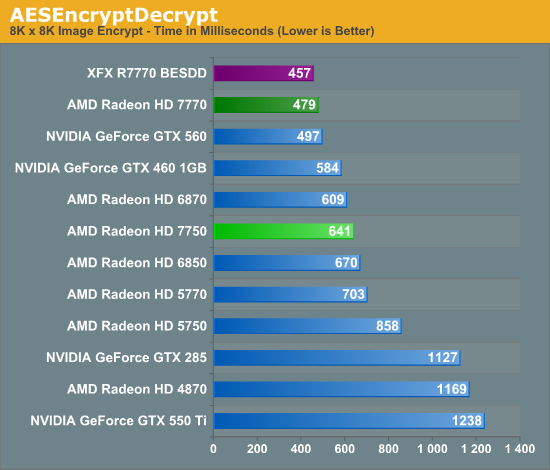AMD Radeon HD 7750 & Radeon HD 7770 GHz Edition Review: Evading The Price/Performance Curve
by Ryan Smith & Ganesh T S on February 15, 2012 12:01 AM EST- Posted in
- GPUs
- AMD
- HTPC
- GCN
- Radeon HD 7000
Compute Performance
Moving on from our look at gaming performance, we have our customary look at compute performance. With GCN AMD significantly overhauled their architecture in order to improve compute performance, as their long-run initiatives rely on GPU compute performance becoming far more important than it is today.
With such a move however AMD has to solve the chicken and the egg problem on their own, in this case by improving compute performance before there are really a large variety of applications ready to take advantage of it. As we’ll see AMD has certainly achieved that goal, but it raises the question of what was the tradeoff for that? We have some evidence that GCN is more efficient than VLIW5 on a per-shader basis even in games, but at the same time we can’t forget that AMD has gone from 800 SPs to 640 SPs in the move from Juniper to Cape Verde, in spite of a full node jump in fabrication technology. In the long run AMD will be better off, but I suspect we’re looking at that tradeoff today with the 7700 series.
Our first compute benchmark comes from Civilization V, which uses DirectCompute to decompress textures on the fly. Civ V includes a sub-benchmark that exclusively tests the speed of their texture decompression algorithm by repeatedly decompressing the textures required for one of the game’s leader scenes. Note that this is a DX11 DirectCompute benchmark.

Theoretically the 5770 has a 5% compute performance advantage over the 7770. In practice the 5770 doesn’t stand a chance. Even the much, much slower 7750 is ahead by 12%, meanwhile the 7770 is in a class of its own, competing with the likes of the 6870. The 7770 series still trails the GTX 560 to some degree, but once again we’re looking at the proof of just how much the GCN architecture has improved AMD’s compute performance.
Our next benchmark is SmallLuxGPU, the GPU ray tracing branch of the open source LuxRender renderer. We’re now using a development build from the version 2.0 branch, and we’ve moved on to a more complex scene that hopefully will provide a greater challenge to our GPUs.

SmallLuxGPU is another good showing for the GCN based 7700 series, with the 7770 once again moving well up the charts. This time it’s between the 6850 and 6870, and well, well ahead of the GTX 560 or any other NVIDIA video cards. Throwing in an overclock pushes things even farther, leading to the XFX BESDD tying the 6870 in this benchmark.
For our next benchmark we’re looking at AESEncryptDecrypt, an OpenCL AES encryption routine that AES encrypts/decrypts an 8K x 8K pixel square image file. The results of this benchmark are the average time to encrypt the image over a number of iterations of the AES cypher.

Under our AESEncryptDecrypt benchmark the 7770 does even better yet, this time taking the #2 spot and only losing to its overclocked self. PCIe 3.0 helps here, but as we’ve seen with the 7900 series there’s no replacement for a good compute architecture.
Finally, our last benchmark is once again looking at compute shader performance, this time through the Fluid simulation sample in the DirectX SDK. This program simulates the motion and interactions of a 16k particle fluid using a compute shader, with a choice of several different algorithms. In this case we’re using an (O)n^2 nearest neighbor method that is optimized by using shared memory to cache data.

It would appear we’ve saved the best for last, as in our fluid simulation benchmark the top three cards are all 7700 series cards. This benchmark strongly favors a well organized cache, leading to the 7700 series blowing past the 6800 series and never looking back. Even NVIDIA’s Fermi based video cards can’t keep up.










155 Comments
View All Comments
KaDomoT - Wednesday, February 15, 2012 - link
Soemthing went very wrong during your Skyrim testing. I ran a 6870 in a similar rig (X4 955 @ 3.5ghz, 4gb ram, no ssd) @ 1920x1080 with 4x AA / 16x AF and A LOT of texture mods and my fps was MUCH higher than that. Not only that, but this was before the big performance boost in patch 1.4 / before I had even heard of SkyBoost!Admittedly my card was overclocked a good chunk (955 core / small mem oc) and my cpu had 600mhz on yours but no way that accounts for some massive 35+ fps difference especially when you guys have the performance patch and no mods.
takeship - Wednesday, February 15, 2012 - link
I think what everyone is missing here is that neither the 7750 or 7700 is really a card for builders, but for the OEM system builders, local shops, etc. For that segment, these cards are fastastic. Just look at the power and thermal loads - if you're HP, now you know you can sell the end customer a 7750 "HD Video" build for cheap, or a push the upgrade to 7770 based "HD Gaming" system without changing the power supply or cooling! That's huge for those guys. Simplification of the assembly line, part variety, etc etc. Same thing with Dad at home. Kid wants to play Battlefield? Buck at the shop around the corner knows that 7770 will get him there and then some playing on their "old" 1080p monitor without worrying that he'll see them back in 4 months when the system melts.CknSalad - Wednesday, February 15, 2012 - link
I think it's best to wait for kepler. There's really no point to be an early adopter of ati's 28nm cards. I'm sure the price will be fixed as the way it should comparable to nvidia's offerings. I just hope that nvidia is really taking the time to actually make quality gpus that are fairly mature. I wonder when there will be stable, legitimate drivers for ATI's 28nm cards. Hopefully that will give a decent boost in performance.haukionkannel - Wednesday, February 15, 2012 - link
Well this seems to be the trend. Older cards allways seems to better in bang for the buck department.It has been very slow time in GPU selling, so there are a lot of those old 5xx and 6xxx cards, so they have to sell those out before they can recure the prices for these new... Or nobody would buy those older allready produced cards. It is pity to us consumers, but a must to GPU manufacturers.
At this moment there is allmot none reason for AMD to make old 6xxx series cheaper, because the Nvidia is not making enough pressure. So they release new cards at extreme prices and sell those old card first.
Nogib - Wednesday, February 15, 2012 - link
I have been looking for an upgrade for my 4850 512MB card with a similar great bang for the buck that this card has given me all these years. Guess I'm still going to be looking. 7770 is close, but not enough of a leap to be honest. And while I'm sure the 78xx series will be great, I'm guessing it will be at a $250-$299 price range which is far beyond what I would ever consider spending on a video card. Sigh.Mathos - Wednesday, February 15, 2012 - link
You're right about the price/performance thing for a release.But, you also have to take some things into consideration. Some of the performance difference is likely due to the 6800 cards having a 256bit memory bus, as opposed to 128bit. Even with that standing I'm amazed the 7770 gets as close as it does. The main reason the 7770 is more expensive, I'm thinking is more likely so they can cease production on the 6800 series and dump inventory. The 68xx cards have been out for a while, and have benefited from many driver optimizations, but, you're not likely to see any more performance out of them from driver updates than what they already have. The 77xx cards are still based on a new core, which through driver updates will likely get much better performance over time.
Bottom line for me though, is, does it perform better than the 5770 that I currently have. Which, it does so considerably. More than could be said for the 6770. It also makes me wonder if they aren't gonna end up doing a 7790, basically a cut down pitcairn with a 256bit bus, like they did with the 6790.
chizow - Wednesday, February 15, 2012 - link
lol Hi rarson. :)Looks like you almost get it. Don't worry once the 7800 parts launch it'll fill in the blanks for you. The entire 7-series product stack pricing fails, top to bottom.
marc1000 - Wednesday, February 15, 2012 - link
actually the 7850 is the real star here. a board that does not require pci-e power and is able to almost match the 5770 in performance on most of the games. that was a 100w card.in the other hand, this makes me a little worried about the power requirements of 7800 series. i am hoping that both 7850 and 7870 will require only 1 pci-e power plug. my case is not big enough to handle more heat than that, and this is why i dont upgrade to a GTX560 (2x power connectors).
mczak - Thursday, February 16, 2012 - link
I think for the 7850 there is a possibility it would only have 1 power connector.The expectation is that Pitcairn is roughly "2xCape Verde", which means it should have roughly twice the power draw too. Twice the 7750 power draw is easily under 150W, whereas twice the 7770 power draw is not (well close actually according to measurements, but clearly these cards want to allow powertune +20% settings and overclocking).
That would be similar to HD6850/HD6870 where the 6850 only has one pcie power connector but the 6870 has two.
marc1000 - Thursday, February 16, 2012 - link
i meant 7750 is the star here.